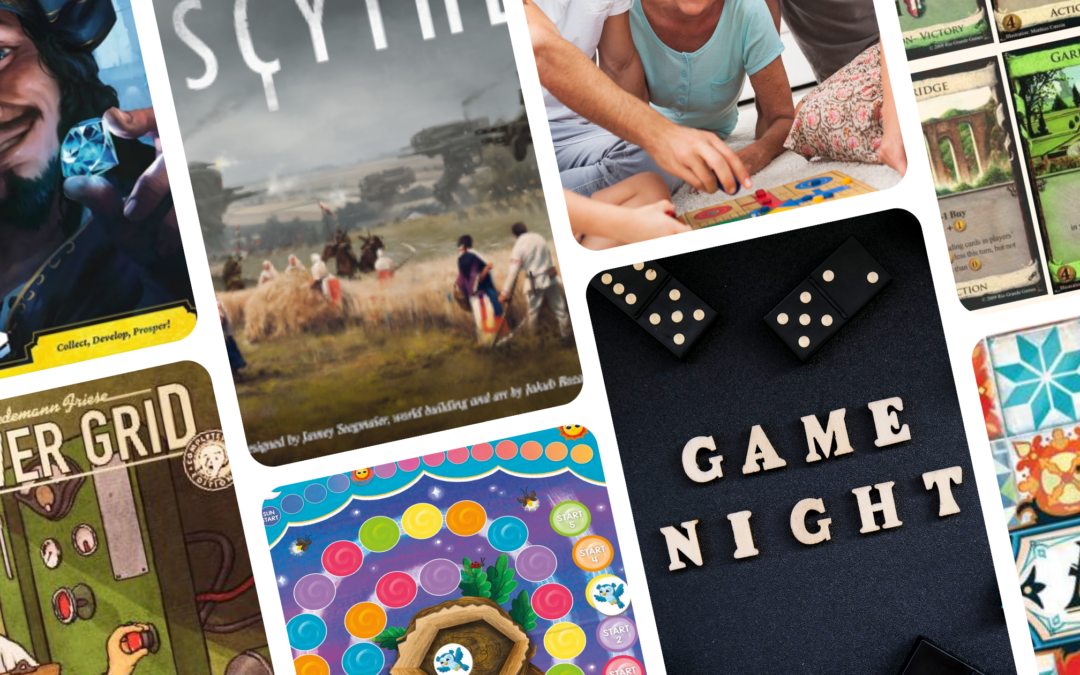Homeschooling with Board Games: Learning Through Play
6 Board Games My Family Can’t Live Without
I’ve always loved board games—whether it’s a lively game night with friends or a cozy match in the living room on a winter evening, there’s nothing quite like it. Now that my family is growing, it’s a pastime I get to enjoy with my kids, too.
But it’s more than just fun and games. Playing board games as a family offers a surprising number of benefits, such as:
- They teach kids important social skills like how to take turns, cooperate, and communicate effectively.
- Board games boost critical thinking skills, encouraging strategic thinking and problem-solving.
- They can enhance focus and attention. Playing board games helps kids practice staying focused for longer periods and learn how to delay gratification.
- Board games encourage healthy competition. Kids learn how to compete in a fun, low-pressure environment.
- They promote emotional regulation. Children learn how to cope with winning and losing, developing resilience and patience.
- Board games build math and literacy skills. Many games involve counting, reading, and other foundational skills that support learning.
- Most importantly, playing board games together can strengthen family bonds. Spending quality time together through games fosters closer relationships and better communication.
Overall, board games are not only fun but also offer a range of developmental advantages.
So, without further ado, here are six of my family’s favorite board games.
1. Hoot Owl Hoot!
Hoot Owl Hoot! is my 4-year-old daughter’s favorite board game. She says, “I love being the owl! I want to get to the nest before the sun comes up!”
In this color-coordinated matching game, players cooperate to help the owls fly back to their nest before the sun comes up. Help all the owls get home before sunrise, and everyone wins!
Hoot Owl Hoot! involves following directions & taking turns. As a cooperative game, it cultivates shared decision-making and learning to work together in a non-stressful play environment.
2. Splendor
My 6-year-old daughter loves Splendor.
Splendor is a fast-paced, deck-building game where players assume the roles of Renaissance merchants striving to buy gem mines, transportation, and shops to acquire the most prestige points.
To build their empires, players must collect gems, acquire developments, and attract noble patrons to amass prestige and become the ultimate gem merchants. My daughter loves collecting colorful gems, and the simple yet elegant buy system is easy for her to understand.
Splendor blends tactical depth with easy-to-learn rules. Quick rounds and short games mean that younger children are less likely to lose interest or get bored before the game ends.
3. Azul
My 8-year-old daughter’s top pick for game night is Azul. This award-winning board game challenges players to create stunning tile mosaics while making strategic decisions and competing for high scores.
Azul features beautifully crafted, colorful tiles inspired by traditional Portuguese azulejos—painted ceramic tiles for making beautiful mosaics. My 8-year-old loves coming up with different patterns with the tiles.
With simple rules and deep strategic choices, Azul is accessible to new players yet offers satisfying complexity for experienced gamers. Each game of Azul provides a unique experience with endless possibilities, making it highly replayable and perfect for repeated enjoyment.
4. Power Grid
Power Grid is a game about earning money by providing electricity to consumers. It’s my 10-year-old son’s favorite game, and for good reason.
Players can earn a profit by generating power and selling it. But how do you do it? Will you use old-fashioned coal or oil? Will you burn garbage? Nuclear power is powerful, but uranium is scarce and expensive. Harnessing solar or wind means you don’t have to compete with others for the purchase of fuel, but the upfront cost can be substantial.
However you decide to generate the energy, you’ll have to compete with your opponents for the best power plants, necessary resources, and sites to build your energy infrastructure. The energy market is constantly shifting. You’ll need to watch what other players are doing, carefully manage your money, and expand your network thoughtfully in order to generate the necessary income required to win. However, be careful. Maybe you can build the largest network or the biggest power plant, but if you can’t afford the resources to power it, then you may fall behind.
My son loves managing his money, building a successful power company, and making a profit. Power Grid really brings out the entrepreneur in him.
5. Dominion
Dominion is a deck-building game and my wife Katie’s personal favorite. It offers endless strategic possibilities as players compete to build the most efficient deck of cards. Each game is different, as the set of available cards changes, allowing for new strategies to be explored each time. The mix of planning, resource management, and decision-making makes it a highly replayable and satisfying experience.
Katie says, “What I love about Dominion is how every game is different. You can tailor your strategy based on which cards are available, and it’s always a challenge to outthink your opponents.” The game’s depth and variety make it appealing for those who enjoy strategic play with a lot of decision-making.
Dominion is a game where you really have to balance your actions. Do you buy more cards to improve your deck, or do you focus on gaining points right away? The tension between short-term and long-term strategy is a key element that keeps our family coming back.
6. Scythe
One of my favorite board games is Scythe, an immersive strategy game set in an alternate-history 1920s, where players control factions competing for resources, territory, and power. The game features beautifully detailed artwork, engaging mechanics, and a rich narrative that offers depth and replayability. Combining resource management, combat, and strategic positioning, Scythe delivers a complex yet rewarding experience for seasoned board gamers.
I love how every decision is impactful in Scythe. You must manage your resources, plan your moves carefully, and adapt to what others are doing. It’s always tense, but in a good way. The balance between long-term planning and reacting to other players is a key reason they enjoy it.
Every player controls a unique faction, each with their own strengths and weaknesses. The asymmetric factions give the game so much replayability. Each faction feels different, and the way you approach the game changes depending on who you’re playing as. The variety in strategies and the unique abilities of each faction add a lot of depth to the game.
Other games combine elements of resource management, worker placement, and combat. But few do so as elegantly as Scythe.
In Conclusion
Board games are more than just a fun way to spend an evening. They’re a tool for growth, learning, and connection. Whether we’re working together to help owls get home in Hoot Owl Hoot! or building complex empires in Scythe or Power Grid, these games provide both entertainment and valuable life skills. As our family grows, these games will continue to offer endless hours of fun, laughter, and learning for years to come.
What are your favorite family board games to play in your homeschool? Join other homeschooling parents in the Homeschool Connections Facebook Group to share your suggestions, questions, or tips.






